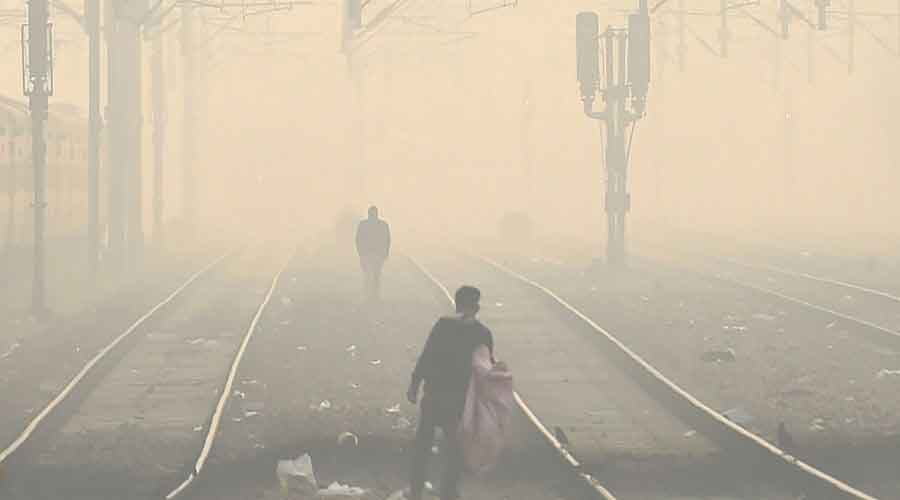
Delhi's post-Diwali air quality worst in five years: Pollution body data
Don't Miss
Residents in many parts of the capital complained of an itchy throat and watery eyes on Friday
 |
| Green crackers were allowed on Diwali in Uttar Pradesh only for two hours in areas with moderate or better air quality.: PTI Photo |
TT Bureau And Agencies | New Delhi | 05.11.21: Delhi recorded its poorest post-Diwali air quality in five years on Friday with a deadly cocktail of noxious fumes from firecrackers and stubble burning pushing the 24-hour average AQI to 462, according to data from the Central Pollution Control Board (CPCB).
The 24-hour average air quality index (AQI) the day after Diwali was 435 last year, 368 in 2019; 390 in 2018; 403 in 2017 and 445 in 2016. The AQI was 382 on Diwali day this year, 414 in 2020; 337 in 2019; 281 in 2018; 319 in 2017 and 431 in 2016.
A thick layer of acrid smog hung over Delhi-NCR on Friday after residents violated the ban on firecrackers to celebrate Diwali and emissions from farm fires in the region peaked at 36 per cent.
Residents in many parts of Delhi-NCR complained of an itchy throat and watery eyes on Friday.
The neighbouring cities of Faridabad (469), Greater Noida (464), Ghaziabad (470), Gurgaon (472) and Noida (475) also recorded ''severe'' air pollution levels.
Ahead of the festive season, the Delhi government had announced a complete ban on firecrackers till January 1, 2022, and ran an aggressive campaign against their sale and use.
The Haryana government had imposed a ban on the sale or use of all kinds of firecrackers in 14 of its districts in the National Capital Region. Green crackers were allowed on Diwali in Uttar Pradesh only for two hours in areas with moderate or better air quality.
An AQI between zero and 50 is considered ''good'', 51 and 100 ''satisfactory'', 101 and 200 ''moderate'', 201 and 300 ''poor'', 301 and 400 ''very poor'', and 401 and 500 ''severe''.
Delhi recorded its poorest post-Diwali air quality in five years on Friday with a deadly cocktail of noxious fumes from firecrackers and stubble burning pushing the 24-hour average AQI to 462, according to data from the Central Pollution Control Board (CPCB).
The 24-hour average air quality index (AQI) the day after Diwali was 435 last year, 368 in 2019; 390 in 2018; 403 in 2017 and 445 in 2016. The AQI was 382 on Diwali day this year, 414 in 2020; 337 in 2019; 281 in 2018; 319 in 2017 and 431 in 2016.
A thick layer of acrid smog hung over Delhi-NCR on Friday after residents violated the ban on firecrackers to celebrate Diwali and emissions from farm fires in the region peaked at 36 per cent.
Residents in many parts of Delhi-NCR complained of an itchy throat and watery eyes on Friday.
The neighbouring cities of Faridabad (469), Greater Noida (464), Ghaziabad (470), Gurgaon (472) and Noida (475) also recorded ''severe'' air pollution levels.
Ahead of the festive season, the Delhi government had announced a complete ban on firecrackers till January 1, 2022, and ran an aggressive campaign against their sale and use.
The Haryana government had imposed a ban on the sale or use of all kinds of firecrackers in 14 of its districts in the National Capital Region. Green crackers were allowed on Diwali in Uttar Pradesh only for two hours in areas with moderate or better air quality.
An AQI between zero and 50 is considered ''good'', 51 and 100 ''satisfactory'', 101 and 200 ''moderate'', 201 and 300 ''poor'', 301 and 400 ''very poor'', and 401 and 500 ''severe''.


0 Response to "Delhi's post-Diwali air quality worst in five years: Pollution body data"
Post a Comment
Disclaimer Note:
The views expressed in the articles published here are solely those of the author and do not necessarily reflect the official policy, position, or perspective of Kalimpong News or KalimNews. Kalimpong News and KalimNews disclaim all liability for the published or posted articles, news, and information and assume no responsibility for the accuracy or validity of the content.
Kalimpong News is a non-profit online news platform managed by KalimNews and operated under the Kalimpong Press Club.
Comment Policy:
We encourage respectful and constructive discussions. Please ensure decency while commenting and register with your email ID to participate.
Note: only a member of this blog may post a comment.